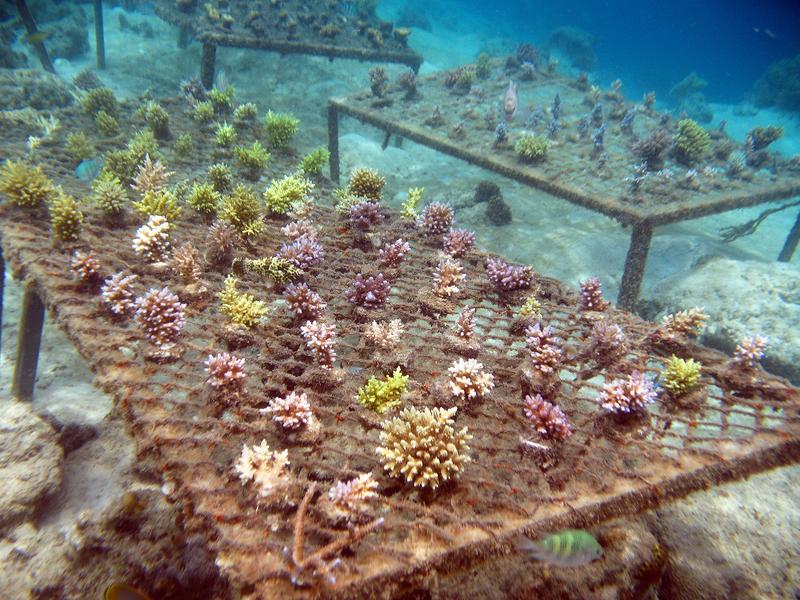

Breeding small coral colonies of different species in shallow water, Indonesia.
Photo: Sebastian Ferse, Leibniz Centre for Tropical Marine Research
“What has been good practice in forestry for many decades has not yet been fully established in reef restoration: often there are no clearly defined goals, no preliminary investigation of the reef condition and causes of damage, and no longer-term monitoring of results afterwards”, explains Dr. Sebastian Ferse, one of the authors of the study.
Ferse is a reef ecologist at the Leibniz Centre for Tropical Marine Research (ZMT) in Bremen and has many years of experience in the restoration of coral reefs.
The measures range from local initiatives of the tourism industry or environmental conservation organisations to scientific studies and large-scale programmes of some governments.
Due to the recent extended mass bleaching, Australia, for example, is currently investing massively in the investigation of various approaches to saving and restoring the Great Barrier Reef, which brings the country's economy a considerable sum of around 6.4 billion dollars annually.
Corals reproduce sexually, but also asexually. If parts of corals break off, they can reattach to the sea floor and grow into a new coral colony. This reproduction strategy is particularly common in branching corals, and is also taken advantage of by one of the most common restoration approaches.
For example, fragments are taken from healthy coral colonies in the reef and transplanted to damaged reef areas. However, this method is only suitable for limited local damage caused for example by ship groundings, storms or blast fishing, because it involves a very high amount of work. In addition, the mother colonies are damaged by the removal of fragments.
Often the coral branches are first allowed to grow in nurseries in calm shallow water or in tanks on land, where they are better protected from harmful influences during their sensitive early growth phase. Above a certain size they are then transplanted. According to studies, about 60 – 70 % of such transplants survive at least the first months in the reef.
“However, the figures are deceptive,” comments Ferse, “because long-term controls are rare. It is quite possible that after only two years less than one in ten transplanted colonies will be alive.”
For these methods, branching corals like those of the genus Acropora are used most frequently, because they are easy to fragment. In many restoration projects, extensive areas of coral monocultures are created, which are poor in other reef species. Since the fragments are clones, the genetic diversity in the coral plantations is highly reduced, and the corals are more susceptible to stress.
Another approach therefore takes advantage of sexual reproduction. The restorers collect eggs and sperm, which many coral species release synchronously into the water as dense clouds. The eggs are fertilised in breeding tanks and grow into larvae, which are then released onto the reef.
However, it can take several years before a larva develops into a small coral colony. Also, large quantities of the small organisms have to be used in this approach, since a large proportion of the released larvae die without ever growing into a coral polyp.
Where a reef is destroyed, coral rubble accumulates on the sea floor, which is moved back and forth by waves and currents. Coral larvae can only settle on stable substrate, however. “When it comes to artificial substrates for colonization, coastal managers have shown a lot of imagination,” says Ferse.
“It's not uncommon for waste to be disposed of under the guise of nature conservation.” Car tyres, concrete blocks, railway wagons and even airplanes are just a few examples. Under water, corrosion can lead to the release of toxins, or tyres and parts of scrap metal may loosen, drift through the reef and cause further damage.
However, the study also shows that despite all objections, coral outplanting using larvae or fragments can be successful in addressing local reef damage. For example, following a ship-grounding off the coast of Florida, the reef could regenerate itself within 10 to 15 years following targeted restoration.
An important prerequisite is that the stress factors causing damage are known and can be eliminated. The ground may have to be cleaned or consolidated for the settlement of coral offspring, preferably with natural materials such as stones.
“But we are not able to recreate an entire coral reef through restoration. We are simply providing a jump-start to get the reef back on track. Ultimately, it must regenerate itself,” says Sebastian Ferse. “Extensive damage caused by climate change and coral bleaching or by eutrophication and sediment pollution of entire sections of the coast present us with new challenges.”
Intensive research is currently being conducted into innovative approaches that can be applied on a large scale. Examples under discussion include autonomous underwater vehicles that release larvae over large areas, or targeted breeding of coral species that are more resistant to ocean warming and bleaching.
Note to the media: At the 14th International Coral Reef Symposium (ICRS), which will take place in Bremen from 5 to 10 July, one topic area will be devoted to reef restoration. Dr. Sebastian Ferse will moderate the “Open Session (13A) – Interventions and Restoration”.
https://www.icrs2020.de/program/session-program/#c245
Dr. Sebastian Ferse
Leibniz Centre for Tropical Marine Research
Tel: 0421 / 23800-114
Email: sebastian.ferse@leibniz-zmt.de
Boström-Einarsson L., R.C. Babcock, E. Bayraktarov, D. Ceccarelli, N. Cook, S.C.A. Heel, B. Hancock, P. Harrison, M. Hein, E. Shaver, A. Smith, D. Suggett, P.J. Stewart-Sinclair, T. Vardi & I.M. McLeod (2020): Coral restoration – A systematic review of current methods, successes, failures and future directions. PLoS ONE 15(1):e0226631. doi:10.1371/journal.pone.0226631.














